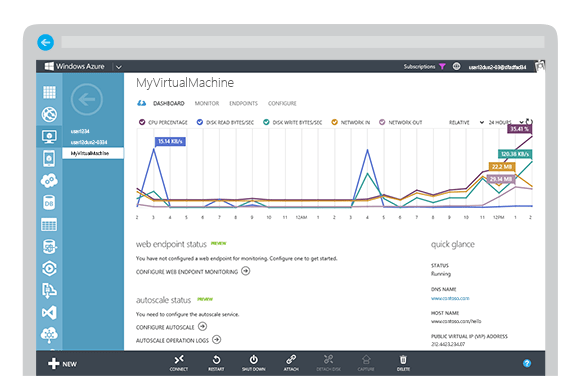After Google’s drastic price cuts for its cloud computing services, Amazon quickly matched them. Given that Microsoft always promised to match prices, it doesn’t come as a surprise that the company today announced its own round of massive price cuts. Prices for compute on Microsoft Azure (previously known as Windows Azure) dropped by up to 35 percent and Microsoft cut storage prices by up to 65 percent.
With these changes, Microsoft matches all of Amazon’s prices and sometimes undercuts them by 1 to 6 percent.
“We recognize that economics are a primary driver for some customers adopting cloud, and stand by our commitment to match prices and be best-in-class on price performance,” the company writes in its announcement today. Today’s announcement comes just a few days ahead of Microsoft’s big BUILD developer conference, but as Microsoft general manager for Azure Steven Martin writes today, “I’ve yet to meet a developer who travels just to hear about pricing updates, so you won’t see us take the stage at BUILD and use the opening moment to announce a price cut.”
The new prices will go into effect on May 1st — a month after Amazon’s and Google’s pricing changes.
In addition to the new pricing, though, Microsoft also today announced a new service level for Azure underneath its Standard tier. These “Basic” instances will cost up to 27 percent less than the regular instances and have similar specs. They do not, however, include load balancing and auto-scaling. As Martin notes, these instances are “well-suited for production applications that do not require the Azure load-balancer (“bring-your-own load balancer” or single instance), development workloads, test servers and batch processing applications.” Their performance, he writes, should be up to par with their equivalent AWS instances. These new instances will be available starting April 3.
As far as storage goes, Microsoft is dropping the prices for its regular Block Blob storage to match Amazon’s. In addition, it is also introducing a new redundancy level for its storage service: Zone Redundant Storage (ZRS). Right now, Microsoft keeps your data in two regions separated by “hundreds of miles” by default. With ZRS, you can store three copies of your data across multiple facilities. Those facilities, however, may be in the same region or across two regions. Prices for ZRS will be 37.5 percent lower than for Microsoft regular Geo Redundant Storage.
With this update, Microsoft is also introducing region-specific pricing. This, Microsoft argues, “will help customers save additional money for workloads that have deployment flexibility.” Until now, Microsoft only offered a single price for all of its data centers in the U.S., Asia and Europe. Japan East and West always featured different prices. Now, however, it differentiates between instances that run in its various datacenters (US East, S. Central, West, EU North, Asia Pacific, Southeast and East). The new prices in Asia, it’s worth noting, did not see the same huge price cuts as in other regions and typically just amount to 2 or 3 cents per hour.
You can find Microsoft’s updated price list — and a comparison with AWS’s prices — here.
